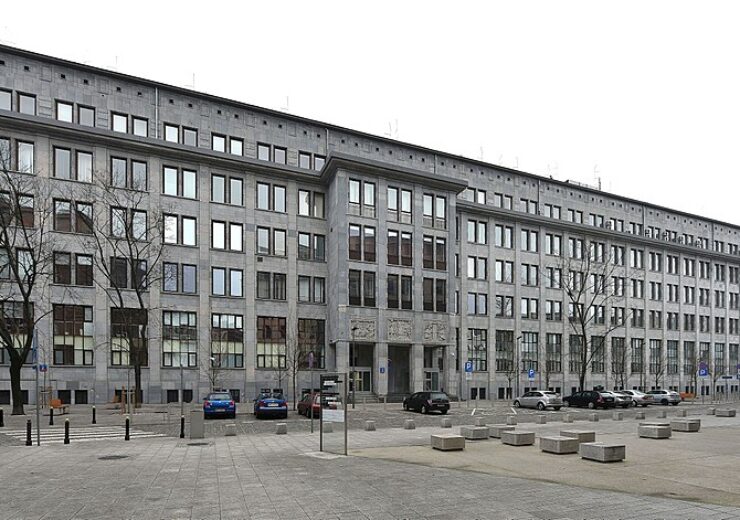This project will intergrate the existing 716 MW Pumped-storage Power Plant at Żarnowiec with BESS resulting in innovative hybrid installation with a power of at least 921 MW and capacity of over 4.6 GWh

PGE's headquarters in Warsaw. (Credit: Adrian Grycuk/Wikipedia.org)
PGE’s unique on a European scale energy storage project in Żarnowiec with a capacity of no less than 200 MW has obtained the first license promise in Poland for electricity storage in a large-scale electrochemical energy storage facility. The promise was issued by the President of the Energy Regulatory Office.
Wojciech Dąbrowski, CEO of PGE Polska Grupa Energetyczna said: “PGE Group is working on the largest energy storage facility in Europe. The project obtained the first license promise in Poland for electricity storage. The strategic goal of the Group in the area of energy storage is to have 800 MW of new energy storage installed capacity in Poland by 2030.
“The energy stores will ensure safe system integration of new renewable energy sources, will contribute to stabilization of the power system and will improve the country’s energy security. The energy storage project in Żarnowiec is in line with the objectives of the European Green Deal with respect to better integration of RES and limiting the use of high emission conventional generation units.”
The project of a large-scale Commercial Hybrid Energy Storage (hereinafter: CHEST) at Żarnowiec Pumped-storage Power Plant (hereinafter: PSPP) with capacity of no less than 200 MW and power output of more than 820 MWh is one of the largest projects of this kind in Europe.
In June 2022, the project obtained the Decision on Environmental Conditions, which is a necessary and crucial step for the continuation of project work. Another milestone in the implementation of the investment was obtaining the first promise of concession for electricity storage in Poland.
Potential for an innovative hybrid plant in Żarnowiec
This project will intergrate the existing 716 MW Pumped-storage Power Plant at Żarnowiec with BESS resulting in innovative hybrid installation with a power of at least 921 MW and capacity of over 4.6 GWh. This corresponds with the capacity of the largest conventional generation units in Poland and will provide energy system regulation services like start- up and restoration of the power system. It will also allow to supply energy to approximately 200,000 households for at least 5 hours (with an average load of 5 kW per household).
In the first quarter of 2022, the planned BESS was registered in the Capacity Market Register, and the project work already underway led to obtaining transmission grid connection permits.
In addition, the BESS will serve the technical and commercial balancing function for volatile renewable energy sources i.e. onshore and offshore wind farms and photovoltaic farms owned by the PGE Group.
The project is proceeding according to the approved schedule. The scale, functionality, location and importance of this project for the National Power System (hereinafter: NPS) as well as the development of RES makes it an innovation not only on a national scale, but also in Europe.
The PGE Group is applying for European funding for the project, as well as is looking for business partners to co-finance the investment.
Energy hub with energy storage support
The project location is about 10 km from the Baltic Sea, where PGE has three location decisions allowing the construction of offshore wind farms with a total capacity of 3.5 GW and approx. 30 km from ESP Żarnowiec. The PGE Group’s “Lotnisko” Wind Farm with a capacity of about 100 MW, with the potential to expand by another 140 MW is also located nearby . All the aforementioned PGE Group assets will be connected to the National Power System through the “Żarnowiec” 400/110 kV substation located approx. 2 km from PSPP Żarnowiec (CHEST) and the “Choczewo” 400 kV substation built for the needs of offshore wind farms in a close distance (approx. 15-20 km) from Żarnowiec substation. Combining the above mentioned units in one area of the NPS will enable integration of the green electricity generated from these assets and will increase their flexibility and controllability.
The potential of the planned hybrid installation may also prove helpful in increasing the energy security of Poland and the Baltic States. It will also have an impact on the competitiveness of energy markets and the synchronization of the Lithuanian, Latvian and Estonian power systems with the system of continental Europe through the Harmony Link project, which is an electricity interconnector between Lithuania and Poland. The link will connect the Lithuanian and Polish electricity system via a 330-kilometer-long submarine cable between the Żarnowiec and Dorbian substations in Lithuania.
Source: Company Press Release
